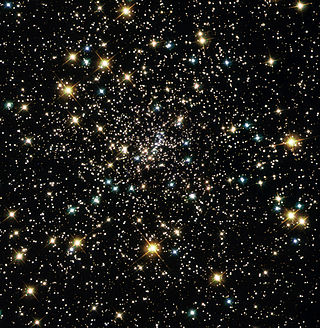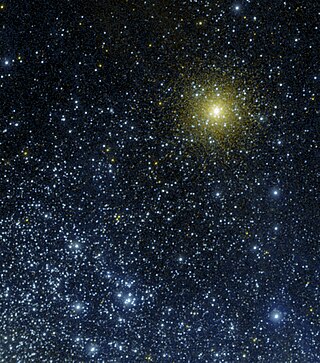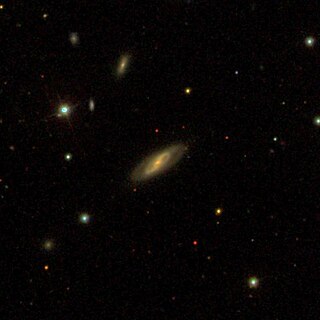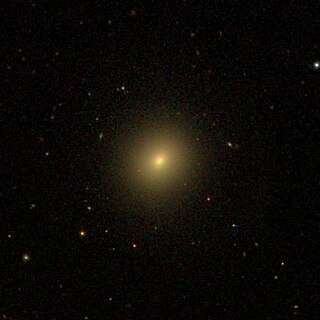
NGC 6397 is a globular cluster in the constellation Ara that was discovered by French astronomer Nicolas-Louis de Lacaille in 1752. It is located about 7,800 light-years from Earth, making it one of the two nearest globular clusters to Earth. The cluster contains around 400,000 stars, and can be seen with the naked eye under good observing conditions.

NGC 189 is an open cluster in the Cassiopeia constellation. It was discovered by Caroline Herschel on 27 September 1783, and independently rediscovered by John Herschel on 27 October 1829.

NGC 3632 and NGC 3626 is an unbarred lenticular galaxy and Caldwell object in the constellation Leo. It was discovered by William Herschel, on 14 March 1784. It shines at magnitude +10.6/+10.9. Its celestial coordinates are RA 11h 20.1m, dec +18° 21′. It is located near the naked-eye-class A4 star Zosma, as well as galaxies NGC 3608, NGC 3607, NGC 3659, NGC 3686, NGC 3684, NGC 3691, NGC 3681, and NGC 3655. Its dimensions are 2′.7 × 1′.9. The galaxy belongs to the NGC 3607 group some 70 million light-years distant, itself one of the many Leo II groups.

NGC 12 is an intermediate spiral galaxy in the Pisces constellation. It was discovered by William Herschel on December 6, 1790.

NGC 31 is a spiral galaxy located in the constellation Phoenix. It was discovered on October 28, 1834 by the astronomer John Herschel. Its morphological type is SB(rs)cd, meaning that it is a late-type barred spiral galaxy.

NGC 362 is a globular cluster located in the constellation Tucana in the Southern Hemisphere, slightly north of the Small Magellanic Cloud, to which it is completely unrelated. It was discovered on August 1, 1826, by James Dunlop. It is visible to the naked eye in dark skies, and is an impressive sight in a telescope, although it is somewhat overshadowed by its larger and brighter neighbour 47 Tucanae.

NGC 4780 is an intermediate spiral galaxy within the constellation Virgo. It is located about 166 million light-years away from the Sun. It was discovered in 1880 by the astronomer Wilhelm Tempel.

NGC 3324 is an open cluster in the southern constellation Carina, located northwest of the Carina Nebula (NGC 3372) at a distance of 9,100 ly (2,800 pc) from Earth. It is closely associated with the emission nebula IC 2599, also known as Gum 31. The two are often confused as a single object, and together have been nicknamed the "Gabriela Mistral Nebula" due to its resemblance to the Chilean poet. NGC 3324 was first catalogued by James Dunlop in 1826.

NGC 74 is a lenticular galaxy located in the Andromeda constellation. It was discovered on 7 October 1855 by Irish astronomer William Parsons.

NGC 113 is an unbarred lenticular galaxy located in the constellation Cetus. It was discovered by German astronomer, Ernst Wilhelm Leberecht Tempel, on August 27, 1876.

NGC 115 is a barred spiral galaxy located in the southern constellation of Sculptor. It was discovered by the British astronomer John Herschel on September 25, 1834. The galaxy is approximately 85 million light-years from the Sun, and is about 50,000 light-years in diameter, nearly half the size of our home galaxy, the Milky Way.

NGC 164 is a spiral galaxy located in the constellation Pisces. It was found by the German astronomer Albert Marth on 3 August 1864.

NGC 468 is a spiral galaxy in the constellation Pisces. Located approximately 209 million light-years from Earth, it was discovered by John Frederick William Herschel in 1827.

NGC 479 is a spiral galaxy in the constellation Pisces. It was discovered by German astronomer Albert Marth on October 27, 1864. It is about 240 million light-years away from Earth.

NGC 920 is a barred spiral galaxy in the Andromeda constellation. The celestial object was discovered on September 11, 1885 by the American astronomer Lewis A. Swift.

NGC 2227 is a barred spiral galaxy with a morphological type of SB(rs)c located in the direction of the Canis Major constellation. It was discovered on January 27, 1835, by John Herschel.

NGC 531 is a barred spiral galaxy in the constellation Andromeda with a visual magnitude of 10.51. It is a distance of 65.7 Mpc from the Sun. It is a member of the Hickson Compact Group HCG 10, and is interacting with the other members of the group.

NGC 937 is a barred spiral galaxy located in the constellation Andromeda about 251 million light years from the Milky Way. It was discovered by the French astronomer Édouard Stephan on 12 December 1884.

NGC 821 is an elliptical galaxy in the constellation Aries. It is estimated to be about 80 million light-years from the Milky Way and has a diameter of approximately 55,000 light years. NGC 821 was discovered on September 4, 1786, by astronomer Wilhelm Herschel.

NGC 823, also known as IC 1782, is an unbarred lenticular galaxy in the constellation Fornax. It is estimated to be 194 million light-years from the Milky Way and has a diameter of approximately 100,000 light years. NGC 823 was discovered on October 14, 1830, by astronomer John Herschel.




















